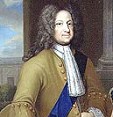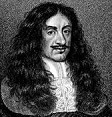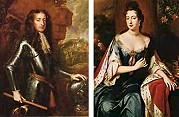James II, tried to make England a catholic country again (the religion of his wife) Parliament did not like this and replaced him with Dutch Prostestant King William III who was married to Mary daughter of James II.
After the last Stewart monarch (Queen Anne) the Hanoverian dynasty (invited by a group of leading Britons) took over thus ensuring a Prostestant succession.
| 1603 |
|
| 1604 |
August - James I ends the war with Spain
The long war with Spain had continued intermittently for 20 years. England and Spain were now at peace for the next 50 years. |
| 1604 |
James styles himself as King of Great Britain |
| 1605 |
5 November - Gunpowder Plot to assassinate James I is discovered
Guy
Fawkes is thwarted when he tried to blow up Parliament. |
| 1606 |
|
| 1607 |
First permanent British colony in North America.
Jamestown in Virginia, founded by Captain John Smith |
| 1611 |
King James Bible is published |
| 1613 |
14 February - James I's daughter Elizabeth marries Frederick V, Elector Palatine.
It was through Elizabeth's descendants that the House of Hanover came to inherit the English throne after the Stuarts. |
| 1616 |
23 April - William Shakespeare dies |
| 1620 |
August - The Pilgrim Fathers set
sail for New England from Plymouth, aboard the 'Mayflower' to escape religious persecution in England. |
| 1624-1630 |
War with  Spain |
| 1625 |
 27 March - James I dies and his son Charles I accedes to the throne 27 March - James I dies and his son Charles I accedes to the throne
|
| 1625 |
14 May - Barbados comes under British control
Captain John Powell landed in Barbados in 1625 and claimed the island as a British Caribbean colony. |
| 1626-1629 |
War with  France |
| 1629 |
Charles I dissolves parliament and begins 11 years of personal rule |
| 1640 |
13 April - 'Short Parliament' opens at Westminster
Desperate for money to fight the Scots, Charles I was forced to summon a new parliament. Only open a month before Charles dissolved it. |
| 1640 |
28 August - Scots defeat the English at Newburn on the River Tyne |
| 1640 |
3 November -'Long Parliament' opens at Westminster
With the Scottish army firmly established in Northern England and refusing to leave until its expenses had been paid, Charles I was again forced to summon a parliament. Many of the members of parliament voiced angry complaints against his policies. |
| 1641 |
October - Rebellion breaks out in Ireland
Several thousand English and Scottish Protestant settlers were killed and many more were forced to flee. |
| 1642 |
4 January - Charles I tries to arrest five leading members of parliament
Fearing that his opponents in parliament were not only determined to seize political control, but also to impeach his Catholic wife, Henrietta Maria, Charles I marched into the House of Commons and attempted to arrest five leading members of parliament. Forewarned, they slipped away and Charles was forced to leave empty-handed. |
| 1642 |
22 August- Civil War begins as Charles I raises his standard at Nottingham |
| 1642 |
23 October - Royalist and Parliamentarian armies clash at Edgehill, Warwickshire |
| 1643 |
25 September - Parliamentarians enter into an alliance with the Scots |
| 1646 |
5 May - Charles I surrenders to the Scots |
| 1649 |
30 January - Charles I is executed at Whitehall, London |
| 1649-1650 |
Cromwell's conquest of  Ireland Ireland |
No monarch England became a Republic for eleven years from 1649 - 1660 |
| 1650-1652 |
Cromwell's conquest of  Scotland Scotland |
| 1651 |
1 January 1651 Charles II is crowned king of Scotland |
| 1651 |
3 September Oliver Cromwell defeats Charles II at the Battle of Worcester |
| 1652 |
Tea arrived in Britain  |
| 1653 |
16 December - Oliver Cromwell makes himself Lord Protector
Cromwell’s self-appointment as 'Lord Protector' gave him powers akin to a monarch. His continuing popularity with the army propped up his regime.
|
| 1660 |
|
| 1660 |
1 January - Samuel Pepys starts his diary |
| 1664 - 1665 |
29 May - The Great Plague of London killed more than 100,000 people died. By the time the epidemic finished in December 1665, a quarter of the capital's inhabitants had perished.
|
| 1666 |
|
| 1667 |
June - Dutch ships attack the English fleet in the River Medway |
| 1677 |
4 November - Mary Stuart marries William of Orange, Charles I's grandson
Mary Stuart was the elder daughter of Charles II's brother, James, Duke of York (James II). Her marriage in 1677 to the Dutch Protestant Prince William of Orange, himself the grandson of Charles I, strengthened William's claim to the English throne. |
| 1685 |
 6 February 1685 Charles II dies and his brother James II accedes to the throne 6 February 1685 Charles II dies and his brother James II accedes to the throne
|
| |
James II suspends parliament indefinitely |
| 1687-1688 |
James II attempts to re-catholicize England |
| 1688 |
10 June - Birth of a Catholic male heir, James Edward Stewart
sparks popular outrage. Many of James II's opponents, furious that their Catholic king now had a male heir, denounced the infant as an imposter, and claimed that the baby had been smuggled into the queen's bedroom in a warming-pan. |
| 1688-1689 |
The Glorious Revolution - the overthrow of King James the II, the crowning of William of Orange and his wife Mary II, and the final recognition of parliament supremacy. |
| 1689 |
|
| 1689 |
16 December English Bill of rights 1689
From now on England's monarchs ruled in partnership with Parliament. |
| 1690 |
1 July - William III defeats James II at the Battle of the Boyne, Ireland |
| 1692 |
William III massacres the
Jacobites at Glencoe |
| 1694 |
Bank of England is established to manage mounting debts |
| 1694 |
December 1694 Mary dies, leaving William III to rule alone
William III's wife Mary died at the age of 32 leaving no children. |
| 1701 |
English Act of Settlement secures the Postestant Succession
placing the House of Hanover in line for the English throne |
| 1702 |
 8 March - William III dies and his sister-in-law Anne accedes to the throne 8 March - William III dies and his sister-in-law Anne accedes to the throne
William III died two weeks after being thrown from his horse when it tripped over a molehill in Hyde Park, London.
|
| 1707 |
England and Scotland officially became one country - Great Britain
The Scottish parliament was dissolved and England and
Scotland became one country - Great Britain
Act of Union between  Scotland
and Scotland
and  England - part of the Union flag story England - part of the Union flag story |
| 1710 |
St Paul's Cathderal, London, completed by Sir Christopher Wren |
| 1711 |
First race meeting held at Ascot |
| 1714 |
 1 August - Anne dies and George I accedes to the throne 1 August - Anne dies and George I accedes to the throne
Anne, the last Stuart monarch, died at Kensington Palace in London aged 49. None of her children survived her, so under the terms of the Act of Succession of 1701 she was succeeded by George, Elector of Hanover, who was proclaimed as George I. He was the first of the Hanoverian monarchs.
|

 24 March James VI of
24 March James VI of  27 March - James I dies and his son
27 March - James I dies and his son  Restoration of the Monarchy
under
Restoration of the Monarchy
under 
 6 February 1685 Charles II dies and his brother
6 February 1685 Charles II dies and his brother  13 February
13 February  8 March - William III dies and his sister-in-law
8 March - William III dies and his sister-in-law  1 August - Anne dies and
1 August - Anne dies and 




 ©
© 
